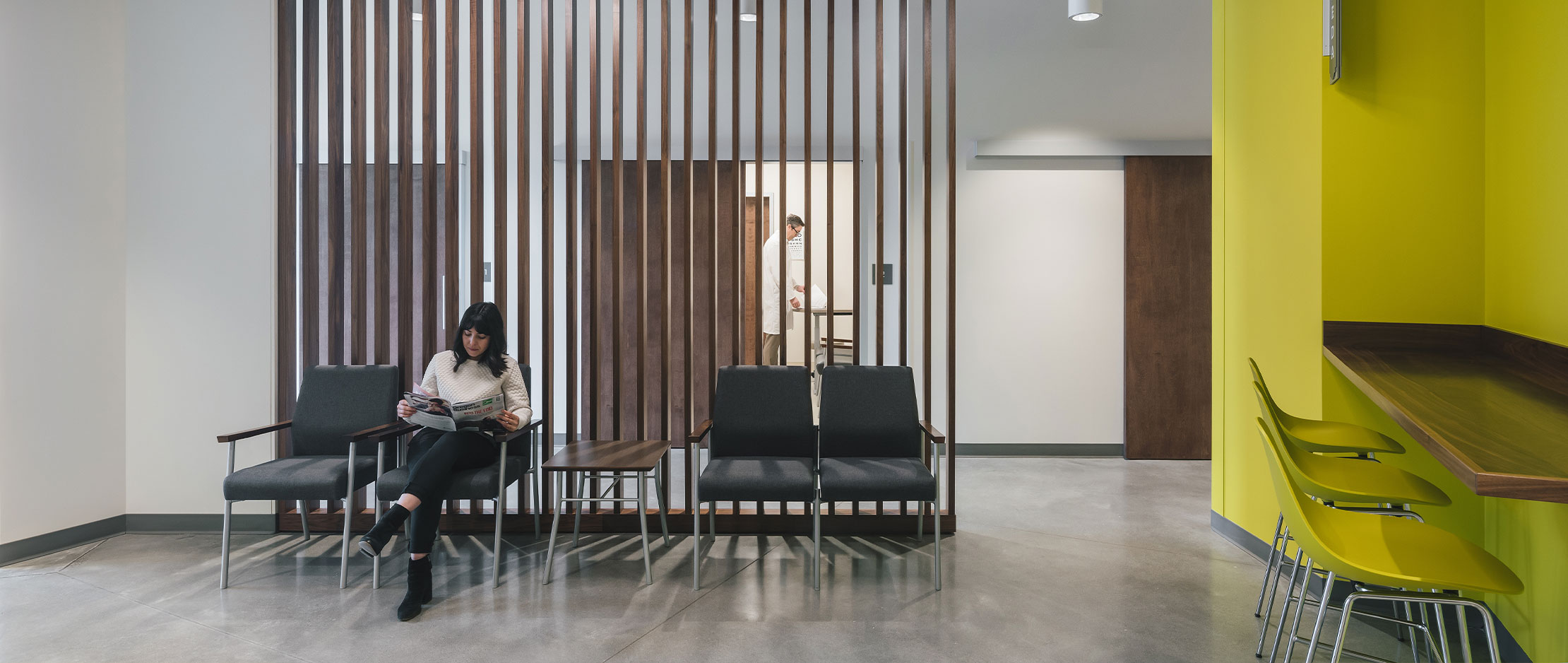
The Next 100
Leaning into the future

For a glimpse inside the future of care at The Portland Clinic, step into our newest branch, where it’s already taking shape.
At The Portland Clinic-Northeast, which opened in 2018, the Lean design principles of efficiency and value embraced by many other professions have found their way into health care. Here, waiting rooms have been eliminated, because patients shouldn’t have to wait for their scheduled appointments. At most, patients might stop briefly at “pause areas” before moving on to their own spacious exam rooms.
Once comfortably settled into a room, that’s where patients stay for most of their visit. No more stepping on a scale in the hallway or being shuttled elsewhere for lab work — each exam room is equipped to accommodate all necessary care. On the walls, eye-catching artwork featuring neighborhood landmarks sets a bright mood and helps patients feel right at home.

We’re looking ahead to a bright future, and to new ways to serve our patients in the next 100 years...how that will materialize is still being designed, but telemedicine will surely continue to be a part of our convenient, high-quality service.
“We’re trying to make the process as efficient, comfortable and satisfying for our patients as we can,” explains Lauren Roberts, M.D., the branch’s medical director (now retired). And patients are appreciating the changes.
“I think it’s fabulous,” says Helen, a patient of the Northeast clinic. “I love coming here — it’s so cheerful. Everything is streamlined. I couldn’t have planned this any better.”
Some of the innovations contributing to the streamlined experience are less noticeable to patients. Open work pods have replaced private offices, fostering better communication among providers. A call center, staffed by nurses and medical assistants, responds quickly to patients who need information rather than appointments. Fast-paced staff “huddles” start each workday, getting everyone up to speed with fewer time-consuming meetings and emails.
One of the most visible and popular changes has been the addition of Basics Market, a modern, nutrition-focused grocery store, into the ground floor of the building. “The medical profession as a whole has been criticized over the years for not being too sharp with their patients when it comes to eating and nutrition,” says Dick Clark, CEO of The Portland Clinic. “That’s changed in a major way as a result of what’s happening through Basics.”
The locally owned “grocery store with purpose” sources fresh ingredients from nearby farms and dairies, provides healthy recipes and offers on-site cooking classes to simplify shopping and promote good health. Now, when providers prescribe better diets and healthier nutrition, there’s a convenient place where they can send patients to put their plans into action — right downstairs.
As Dr. Roberts sums up, “Doctor-patient relationships are still at the very heart of good health care. But finding new and better ways to deliver that care makes those relationships even healthier.”
Looking ahead
Many of the helpful innovations built into the Northeast branch are likely to be incorporated into other branches in the near future. Large waiting rooms, for example, will probably go away. While efficiency was the original goal behind eliminating waiting rooms at the Northeast clinic, COVID-19 revealed another benefit: reduced exposure among patients.
In a post-pandemic world, health care at our clinics is likely to continue to embrace a combination of telemedicine and in-person patient visits, as well. “Ultimately, it’s our patients who will push us to continue to offer telemedicine across all of our specialties,” predicts Shannon Diede, The Portland Clinic’s chief operations and information officer. As the population grows, she expects, convenience will drive more patients to request telemedicine for visits that don’t require seeing a doctor in person. “I’m really excited about that,” she says. “I think it’s our future.”
Clark agrees. “We’re looking ahead to a bright future, and to new ways to serve our patients in the next 100 years,” he says. “How that will materialize is still being designed, but telemedicine will surely continue to be a part of our convenient, high-quality service.”
Building for tomorrow
To meet the needs of Portland’s most rapidly expanding neighborhoods, the clinic’s physician partners, associates and executives are considering adding new branches in north Portland and on the city’s east side.
At the center of the clinic’s expansion plan is a new state-of-the-art facility that will replace the current Downtown branch, which is now nearing its 50th birthday. Like the current building, the new branch will be conveniently located downtown. “Our hope is not simply to create another clinic like the one we have right now,” says Clark, “but to make it a more integrated wellness experience.”
Even on the heels of the challenges and setbacks delivered by the pandemic, the clinic’s leaders are optimistic about what lies ahead. “We’ve shown in the past year that we can face tough challenges, make decisions and execute them to continue to do what we do best, which is to take care of our patients,” says chief medical officer Amy Mulcaster, D.O.
Adds Clark, “We’ve done it before, we can do it again, and the patients we serve are counting on us to do so.”